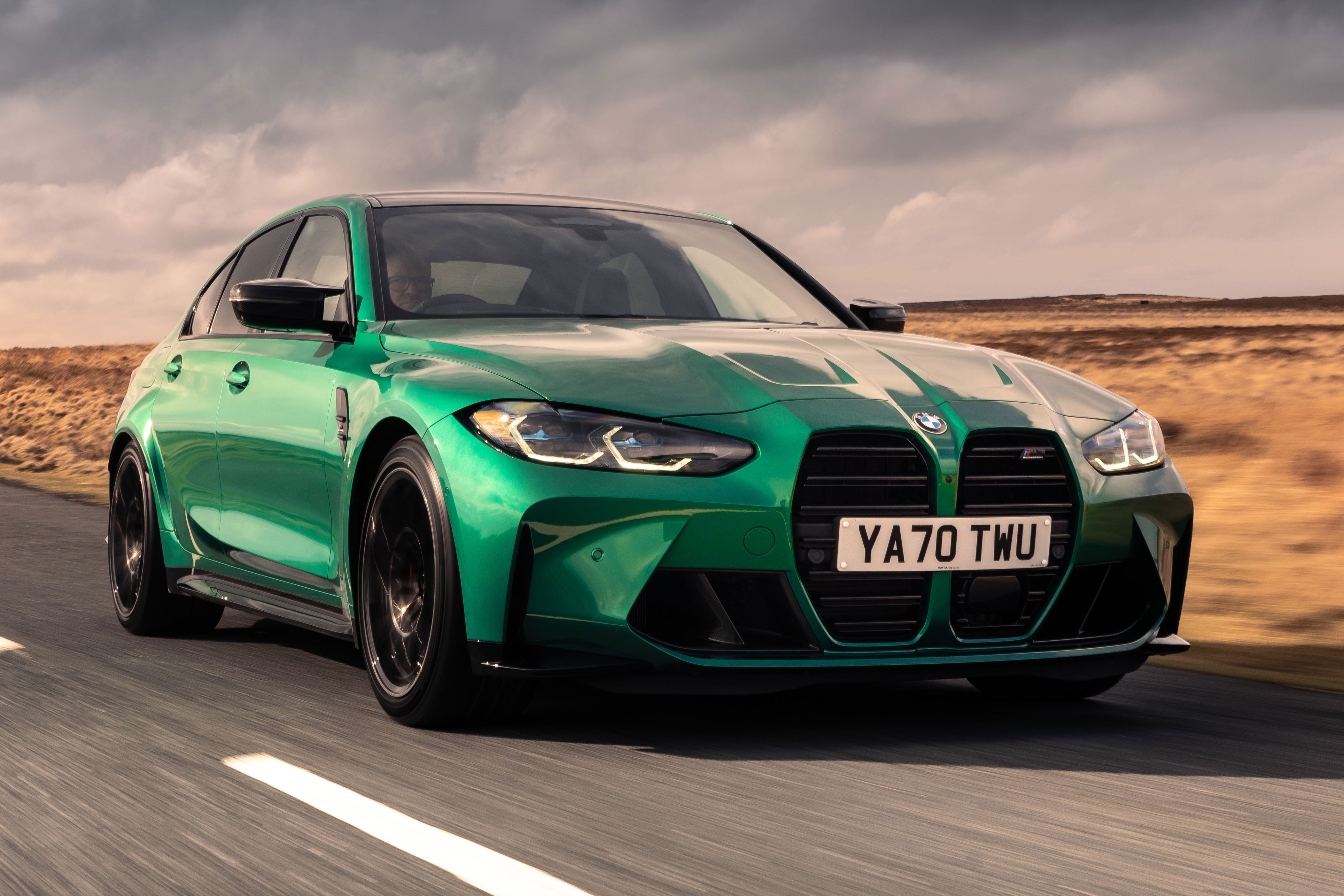BMW M3 Review 2025: Price, specs & boot space
Written by Ivan Aistrop
Quick overview
Pros
- Hugely fast and exciting to drive
- Practical and posh interior
- Surprisingly comfortable and civilised
Cons
- Expensive to buy and run
- Optional extras are also costly
- The CS is bonkers money
Overall verdict on the BMW M3
“You don’t get a reputation like the M3’s by accident. BMW has spent almost 40 years honing the concept of the compact performance car, with enormous success, and the latest iteration takes the M3’s legendary dynamic ability to the next level. It’s an absolute masterpiece."
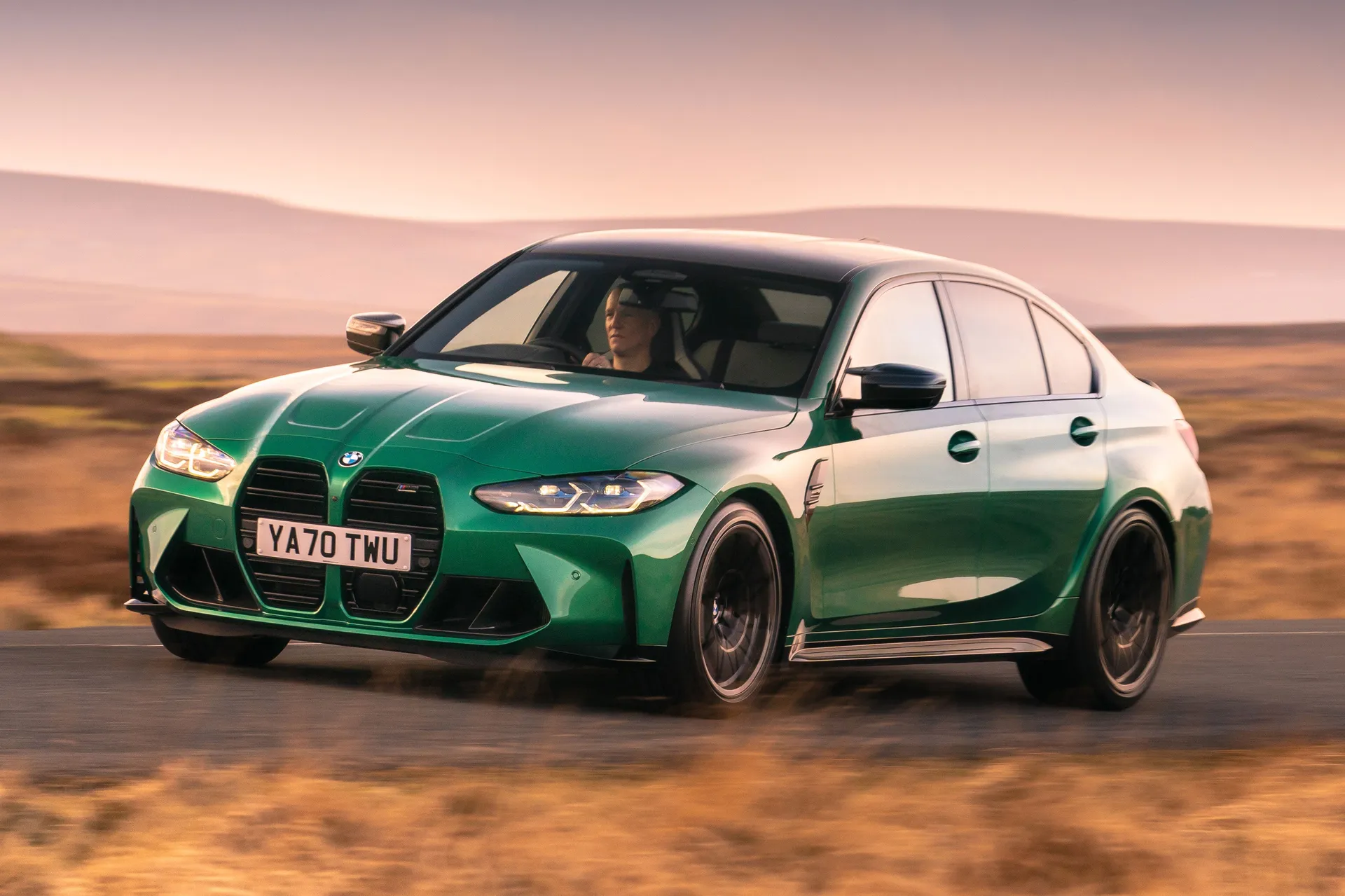
Theodore Roosevelt said that “nothing worth having comes easy”, and that’s probably something that BMW is all too aware of, especially regarding cars like the M3. These days, the BMW M3 enjoys truly iconic status, and is revered as one of the world’s finest and most sought-after performance sports cars. However, this didn’t happen overnight, and it’s taken many years, and generation after generation of engineering wizardry, to get there.
The story began in 1986 with the high-performance BMW M3 version of the contemporary E30 3 Series, which was then - and in most subsequent generations - offered purely in coupe and convertible forms. That changed in 2014 with the fifth-generation M3, which was offered exclusively as a four-door saloon because the coupe and convertible variants had been rebranded as the M4. Today, we’re on the sixth iteration of BMW’s bombastic bruiser, and it’s offered in both saloon and - for the first time - M3 Touring estate forms. That’s not far off four decades of invention, ingenuity and effort, constantly reimagining and fine-tuning the formula to keep the M3 on top of the performance car pile where it belongs. And it’s been worth it, because that’s where it remains today.
The latest BMW M3 is simply sensational, and it’s come a long way from the relatively simple pokier-engine-and-tweaked-suspension approach of the original. As is appropriate for the time, the latest car is as much a technological exercise as it is an engineering one.
Delve into the menus of the glossy-looking touchscreen, and there’s a seemingly endless array of driving mode configurations that offer a variety of settings for everything from the steering, brakes, throttle, exhaust, adaptive suspension - you wouldn’t be surprised if you could alter the car’s inside leg measurement at the touch of a button. And that’s before you’ve even started with the completely separate variable settings for the automatic gearbox, traction control system, driver assistance functions, etc, etc…
However, take the time to set it all up as you like it - or just settle for the excellent default combinations that BMW has chosen for you - and you’ll be rewarded with a car that will never fail to thrill you, with both its raw speed and its unbelievable agility. And, when you’re not driving it like your trousers are on fire, you’ll be staggered by how comfortable, cosseting and civilised it can be, with a smooth ride, spacious five-seat cabin, sumptuous interior quality and plentiful luxury equipment.
In both engineering and technological terms, this car is an absolute masterpiece. Yes it’s expensive, but masterpieces don’t usually come cheap, and if you can afford it, you’ll enjoy it so much every single day that you’ll never, ever feel short-changed.
Looking for a used car for sale? We've got 100s of BMW Approved Used Cars for Sale for you to choose from, including a wide range of BMW M3s for sale. If you're looking for the older version, you need our BMW M3 (2014-2020) review.
Is the BMW M3 right for you?
If you want the finest high-performance saloon car (or estate - they do those too) currently on the market, then yes it is. If you’re the sort of person that values heritage and the historical lineage of where that fast saloon car has come from, then yes it is. If you want a car that can transport the kids to ballet practice one day, your colleagues to business meetings the next, and then set lap records at the weekend, then yet it is. If you want a car that’ll provide thrills and luxury in equal measure, then yes it is. The BMW M3 might just be the car that does everything. Provided you can afford to run it, that is.
What’s the best BMW M3 model/engine to choose?
If you just want the best BMW M3 money can buy, you’ll want the CS version. Not only does this version have an extra 40 horsepower from its twin-turbocharged 3.0-litre straight-six petrol engine, taking the grand total up to 545PS, but it also gets a recalibrated exhaust that makes it sound better, extra lightweight body part to make it more agile, and a reworked suspension that makes it both more comfortable and more capable. However, do bear in mind that this version costs a great deal more than the standard M3 Competition, not to mention the fact that it’s a limited-edition, so finding one might be extremely difficult, so you’ll have to decide for yourself whether it's worth the extra hassle and cost, especially when the standard BMW M3 is already so good.
You can also choose whether your BMW M3 has rear-wheel drive or four-wheel drive, and controversially, we’d opt for the latter. It provides that extra cornering capability and all-weather ability when you need it, but when you don’t, you can simply switch the system to rear-drive mode for tail-happy thrills.
What other cars are similar to the BMW M3?
As a high-performance saloon car packing a six-cylinder engine with upwards of 500 horsepower, arguably the M3’s most direct rival is the Alfa Romeo Giulia Quadrifoglio. Then there’s the latest four-door offering from Affalterbach in the form of the Mercedes-AMG C63 S E Performance. This replaces its predecessor’s hulking V8 with a four-cylinder petrol engine and a plug-in hybrid system, so it’s not quite a direct rival, a fact punctuated by the fact that this concoction in the Merc bestows it with a frankly bonkers 680PS. There’s no Audi RS4 saloon on offer at the moment, so the RS5 Sportback is another alternative, or if you’re considering the M3 Touring Estate, then the Audi RS4 Avant will also be of interest to you.
Comfort and design: BMW M3 interior
"The BMW M3’s cabin may have an appropriately sporty feel, but it doesn’t feel like some sort of stripped-out racer. This is still a very classy place in which to spend time, and with plenty of space for passengers and baggage, it’s a practical everyday car as well."
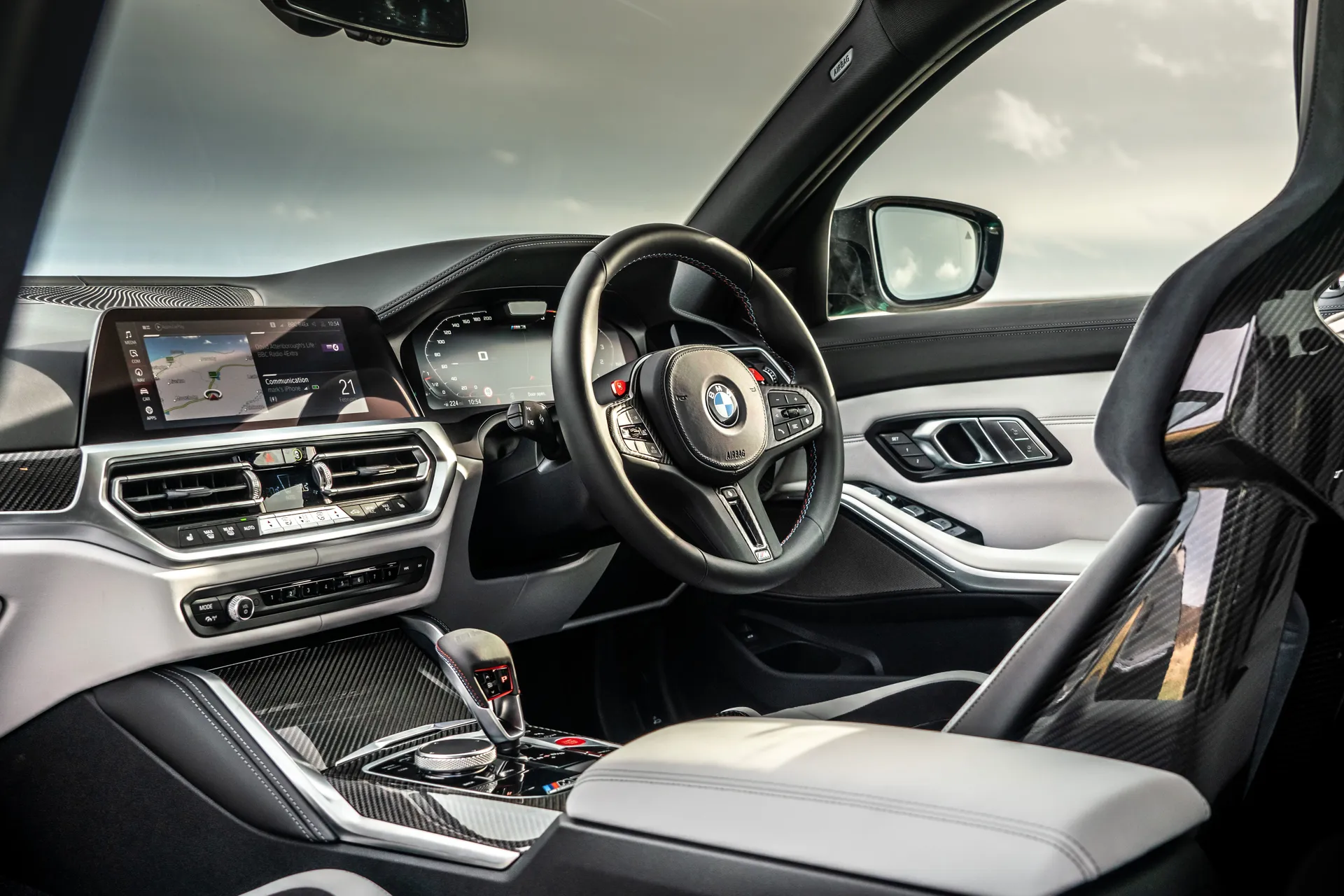
The driving position in the BMW M3 is absolutely spot-on, and just what you want in a car like this. The electrically adjusting driver’s seat goes nice and low for that low-slung, butt-on-the-floor feeling, and the steering wheel and pedals line up perfectly.
The CS version has M Carbon bucket seats as standard (these are a very expensive option in the BMW M3 Competition), which are made largely from the same lightweight CFRP (Carbon-Fibre-Reinforced Plastic) as the M3’s roof and various elements of the bodywork. Like the regular seats, they’re upholstered in leather, heated, and are fully electrically adjustable. They’re wonderfully supportive and they grip you even tighter when you’re hurling yourself around bends, but the heavy side bolstering can make it tricky to get into the car without bashing your backside.
Despite most functions being controlled through the infotainment system (more on that in a moment), there are a number of buttons and switches dotted around for various things, and it’s not immediately obvious what many of them do, but it shouldn’t take too long to work it all out. Visibility is pretty good at both ends of the car thanks to the slim pillars that flank both the front and rear screens.
Quality and finish
You’d expect any car with a BMW badge - especially one that costs as much as this - to be fairly dazzling when it comes to interior quality, and happily, the BMW M3 doesn’t disappoint. Everywhere you look, the cabin is lined with touchy-feely surfaces, highlighted with metallic elements and carbon fibre finishes, while many other surfaces are covered in sumptuous stitched leather. You’ll also like the fact that all the various switches and dials work with properly slick precision. It all adds up to an environment that feels both posh and sporty, which is exactly the effect that a car like the BMW M3 should deliver.
Infotainment: Touchscreen, USB, nav and stereo in the BMW M3
Early versions of the BMW M3 had a 12.3-inch instrument screen behind the steering wheel, and a 10.25-inch central control screen, but this was later replaced with BMW’s Curved Display infotainment system, which brings together a 12.3-inch instrument screen and a 14.9-inch central control screen, all integrated into one unit that curves satisfyingly around the driver. You also get a head-up display that projects further driving information onto the windscreen in front of you.
It’s a hugely complex system that controls myriad features, but because BMW knows a thing or two about infotainment, it’s also fairly easy to find your way around once you’re used to it, with reasonably logical menus and handy shortcut buttons. Like most such systems these days, it has touchscreen functionality, but happily, it can also be operated with the rotary dial controller found on the centre console, which is easier, more precise and less distracting to use on the move.
The graphics are incredibly sharp and slick, and the system responds quickly to commands. It’s slightly annoying that you have to operate the ventilation system with the central screen, rather than the system having its own buttons and switches, but at least there’s a shortcut to the climate control menu displayed at the bottom of the screen at all times. With the older infotainment system, separate air-con controls were provided.
Features supported by the system include DAB radio, navigation, a Bluetooth phone connection, smartphone integration with Apple CarPlay and Android Auto, wireless phone charging, a wifi interface and an intelligent personal assistant. You also have two USB connections for connecting and charging devices, and a Harman Kardon surround sound stereo system.
Space and practicality: BMW M3 boot space
The BMW M3 is based on the 3 Series executive car, so it’ll be no surprise whatsoever that practicality sits at a very similar level. Those in the front seats have lots of room to stretch out, but happily, those in the back don’t do at all badly, either. There’s lots of legroom on offer, and headroom is generous enough for six-foot-plus adults to sit comfortably. The three-seat rear bench is actually much better for two people, though: the middle seat is hard and raised, and there’s a transmission tunnel in the floor that eats into foot space, but it’s more the fact that the cabin is too narrow to comfortably accommodate three sets of shoulders. Your friends or colleagues might be able to stick it for short distances, though.
The boot in the BMW M3 Saloon is a very decent size at 480 litres, giving you plenty of space for family clutter, but the opening is rather shallow, so wedging larger items in might be tricky. There’s also a slightly awkward load lip to negotiate. If you need more cargo-carrying capability in your M3, then the latest incarnation is also available in Touring estate form. It doesn’t have that much more capacity at 500 litres, but the access is way better. Both versions have versatile 40-20-40 split-folding rear seats for when you need maximum load-lugging capacity. The folded seats lie at a slight angle, leaving a slope and a small step in the extended loadbay. The loading aperture this opens up in the saloon is small and awkwardly shaped, but again, it’s much bigger and better in the wagon.
Handling and ride quality: What is the BMW M3 like to drive?
"Reputations like the one the BMW M3 has built up over the years do not happen by accident, and the latest incarnation is the finest yet. It’s game-changingly fast and scalpel-sharp one minute, yet docile and civilised the next. It’s a truly seismic piece of engineering."
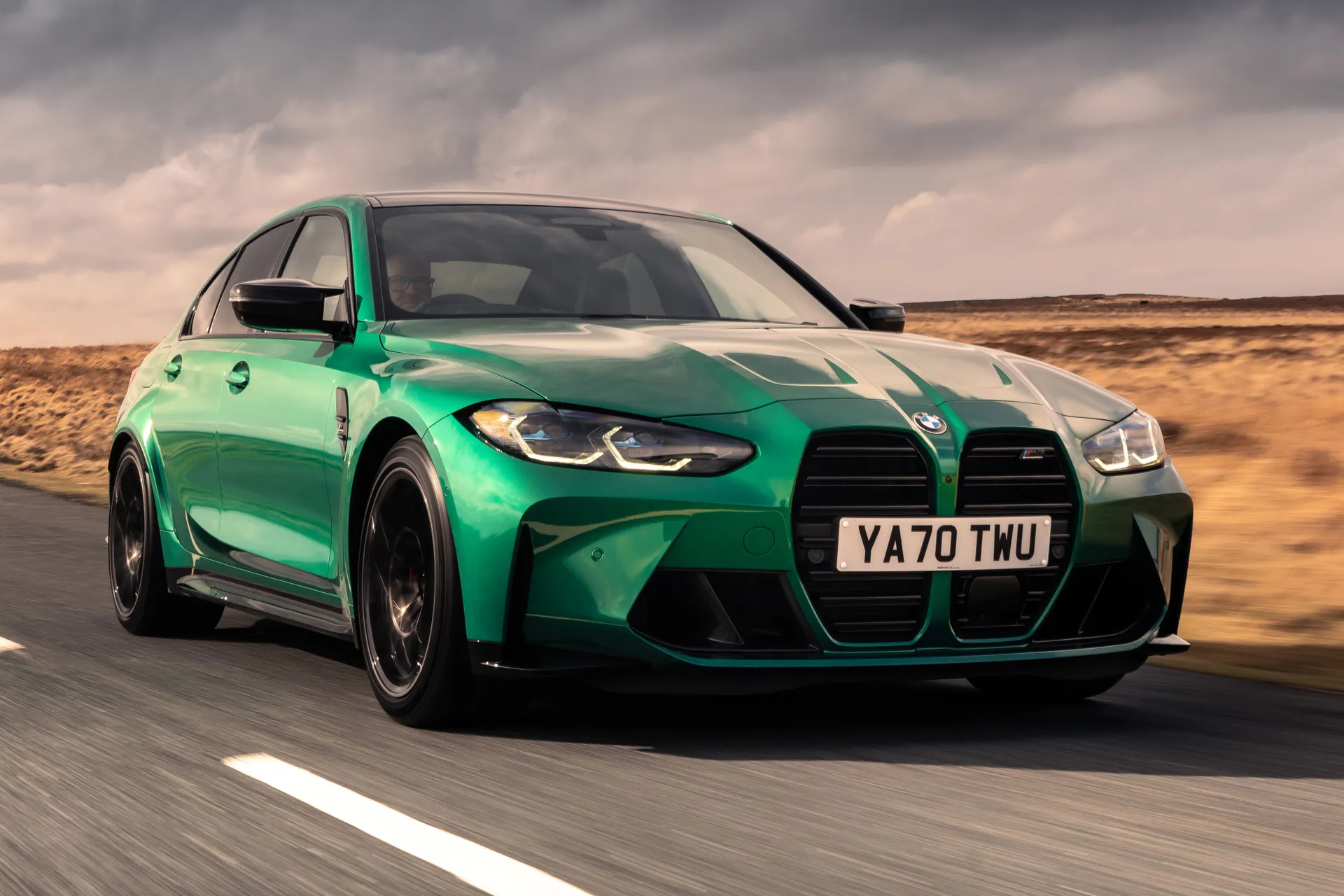
You’d expect any high-performance BMW to give you a variety of drive modes and settings for various parameters that affect the driving experience, but in the M3, this is taken to extremes. Menus on the central screen allow you to select various settings for the steering, throttle response, automatic gearshift, braking system, active exhaust, and - most critically here - the standard adaptive suspension. You can also select your own settings for each parameter individually as you wish, and there are two M modes that you can pre-configure in advance, and then select in an instant with shortcut buttons on the steering wheel.
But that’s just the tip of the iceberg. There’s an extra switch on the gear selector to further govern the shift characteristics of the automatic gearbox, a ten-stage stability control system that allows varying levels of intervention, various settings for the bias of the four-wheel drive system - including one to disable it so that just rear-wheel drive remains - and various other settings to limit or disable the effect of various other safety systems.
With such a high level of configurability, it takes some time to fine-tune exactly which settings are your favoured ones, but the default driving modes offered by the car give you a good starting point. Select the most relaxed one, and you’ll be staggered by how gentle and easy-going the car feels. The ride in particular is impressively compliant, absorbing lumps and bumps of all shapes and sizes with real slickness, while light steering and consistent control weights make this a very easy car to plod around town in. It doesn’t feel anything like the highly-strung performance car you might be expecting.
The BMW M3 we drove was the limited-edition CS, a version with lightweight body parts, extra power and a revised suspension to make it more suited for hardcore track use. But despite that, even when you select the most hardcore suspension mode, the ride is still forgiving enough for use on the public road with barely any discomfort. Importantly, however, body control remains super-tight, making the car feel incredibly well tied down when negotiating dips and crests, or when tearing its way through corners at breakneck speed.
The levels of grip and traction on offer from the standard four-wheel drive system are absolutely huge, so much so that it’ll take you a while to build the courage to test the limits of the car (for which you’ll need a track, because you shouldn't be getting anywhere near those limits on the public road). However, there’s enough weight and feel through the steering to encourage you to do exactly that, and the immense speed and responsiveness of the steering also contributes to the effortlessly agile feel of the car, but without making it feel too twitchy or nervous. The overall effect is a car that’s more nimble, more precise, more engaging and more exhilarating than any car of this size has any right to be. What’s more, stick it down any given country road, followed by an Alfa Romeo Giulia Quadrofoglio or Audi RS5 Sportback, and you’ll be leaving your rivals for dust each and every time.
What engines and gearboxes are available in the BMW M3?
The BMW M3 has a twin-turbocharged 3.0-litre straight-six petrol engine, mated to an eight-speed automatic transmission - there’s no manual gearbox option here. In the regular BMW M3 Competition Saloon, you can have it in either rear-wheel-drive or four-wheel-drive forms, while with the BMW M3 Touring estate, and the limited-edition CS high performance (well, even higher performance) version of the saloon, it’s four-wheel drive only.
In the ‘regular’ BMW M3, the maximum power output stands at 510PS, and the official 0-62mph time stands at 3.5 seconds. The top speed is limited to 155mph, unless you add the optional M Driver’s Package, which allows a top speed of 180mph. Pay the (considerable amount) extra that the CS costs, and the power output is hiked up to 550PS, while the 0-62mph sprint time drops to 3.4 seconds. Top speed on this version stands at 188mph. And it was the CS version that we had a go in.
Now, those numbers all sound very impressive, but it’s nothing compared to the experience delivered by the car, and that applies at both ends of the speed spectrum. With the more relaxed driving modes selected, and when you’re just pootling around town, the M3 is a surprisingly easy and tranquil thing to get around in, with and engine that’s tractable and composed, controls that are consistent and easy to modulate, and a gearbox that slushes between ratios smoothly and cleanly. Get a few more revs on the dial, though, and the exhaust starts to sound naughtier and your speed rises exponentially: even in these modes, the car is capable of truly searing pace, especially if you find the bravery to rev it out to its dizzying 7,200rpm limit.
Switch the car into the more hardcore modes, however, and things become even more bonkers. With the transmission primed for maximum attack, the acceleration becomes even more brutal, and each upshift is punctuated by a burp from the exhaust and small extra surge of forward momentum, while each downshift results in theatrical spits and cracks from the exhaust. Monstrously fast and with no shortage of drama, if you can’t get excited about driving this car, then you’ll never be excited by any car.
Refinement and noise levels
In the CS that we drove, the engine is the thing that dominates here, and as we’ve said, it’s enormously impressive. It’s quiet, smooth and subdued when you’re driving gently, and it’s distant and relaxed at a motorway cruise, yet when you’re getting a move on, it delivers the sort of aural theatre that will have your pulse racing on its own, regardless of the pace you’re experiencing. We have heard it said that the regular M3’s engine and exhaust don’t deliver quite the same drama in terms of noise, and having not driven the car, that’s not something we can substantiate or otherwise, but we can’t imagine it would be an entirely soulless experience.
Wind noise isn’t an issue at motorway speeds, but you do hear a fair bit of road noise. Then again, when you consider the incredible width of the tyres beneath you, that’s not entirely surprising.
Safety equipment: How safe is the BMW M3?
The current BMW 3 Series was crash-tested by Euro NCAP way back in 2019, and achieved the full five-star rating, but because the testing thresholds get harder and harder to ace each year, we don’t know if the score would be the same were it tested today.
The BMW M3 comes with a generous roster of safety kit as standard. This includes a vast variety of driver aids including a parking assistant, forward collision warning with automatic brake intervention, lane departure warning, lane keep assist, attention alert, speed limit assist and an emergency call function. A Driving Assistant package is also included, that brings lane change warning, rear cross traffic alert and rear collision prevention.
MPG and fuel costs: What does a BMW M3 cost to run?
"Running a BMW M3 is never going to be cheap, but importantly, the figures suggest that it should be no more expensive than running one of its high-performance rivals. Even so, expect to fork out lots for petrol, tyres, insurance and maintenance."
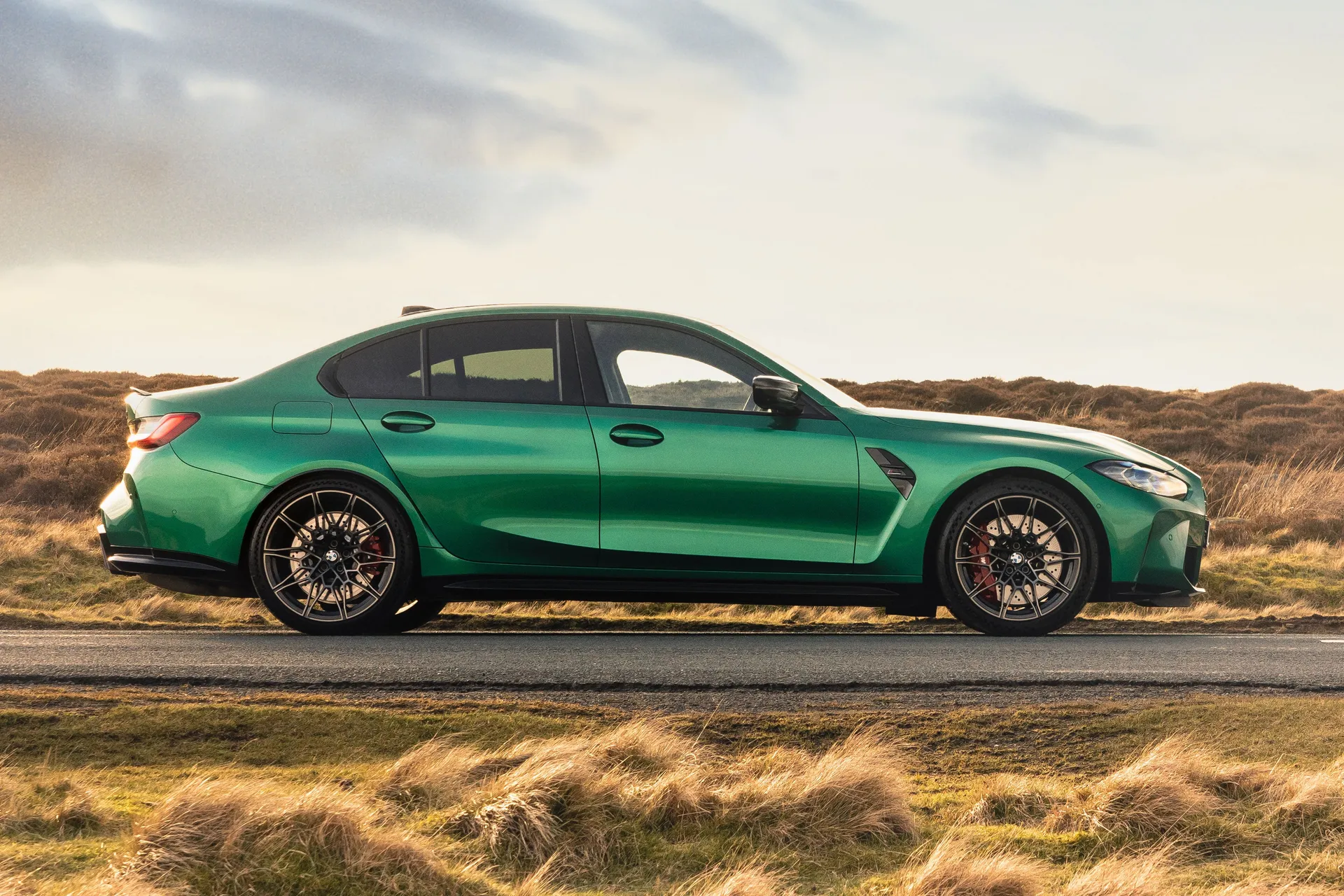
You wouldn’t expect to run an BMW M3 on a shoestring budget, and you most certainly won’t, but fuel costs shouldn’t be any more horrendous than they are on any other performance car of this sort. According to official figures, the rear-wheel drive Performance model will deliver a fuel return of up to 29.4mpg, while choosing the all-wheel-drive model trims that slightly to 28.2mpg. Even the more powerful CS model isn’t too far behind at 27.9mpg. Do remember, though, that these laboratory tests treat the car extremely gently, so don’t replicate real-world driving conditions, let alone the effects of a heavy right foot. Drive the M3 like it should be driven, and single-figure returns are more likely.
How reliable is the BMW M3?
Take a look at the latest HonestJohn.co.uk Satisfaction Index, and it makes for some quite mixed signals. In the overall customer satisfaction standings, BMW placed 12th out of the 29 manufacturers considered, putting it above average and out-performing rivals Audi and Mercedes-Benz. In the same study, however, this generation of 3 Series featured 10th on the top 10 list of least reliable cars, which is a concern given the vast amount of models considered.
Insurance groups and costs
All cars have an insurance classification that runs from group 1 (the cheapest grouping) to group 50 (the most expensive). Look at a car like the BMW M3, with its lofty price tag and power output upwards of 500PS, and you might automatically assume that it would slot straight into group 50, but that’s actually not the case. Rear-drive versions of the Competition actually slot into group 41, while four-wheel drive variants sit in group 42. OK, so insurance premiums won’t be pence, then, but by the same token, they might not be as astronomical as you might expect. The CS only has an extra 40 horsepower, but that hikes its classification up to group 49, likely due to its considerably higher price.
VED car tax: What is the annual road tax on a BMW M3?
Despite its monstrous power, the BMW M3 is taxed at the same flat rate as any other petrol-powered car, which stands at £180 per year. Do be aware, however, that because all versions cost (considerably) more than £40,000 to buy new, they’re classed by the exchequer as luxury cars, meaning that you must pay an additional surcharge on top of that for five years, between years two and six of the car’s life. That surcharge amounts to £390, taking your annual road tax bill for that period up to £570.
How much should you be paying for a BMW M3?
"There’s no such thing as a cheap BMW M3, even on the used car market, but that doesn’t mean there are hefty savings to be made by buying an example that’s a couple of years old."
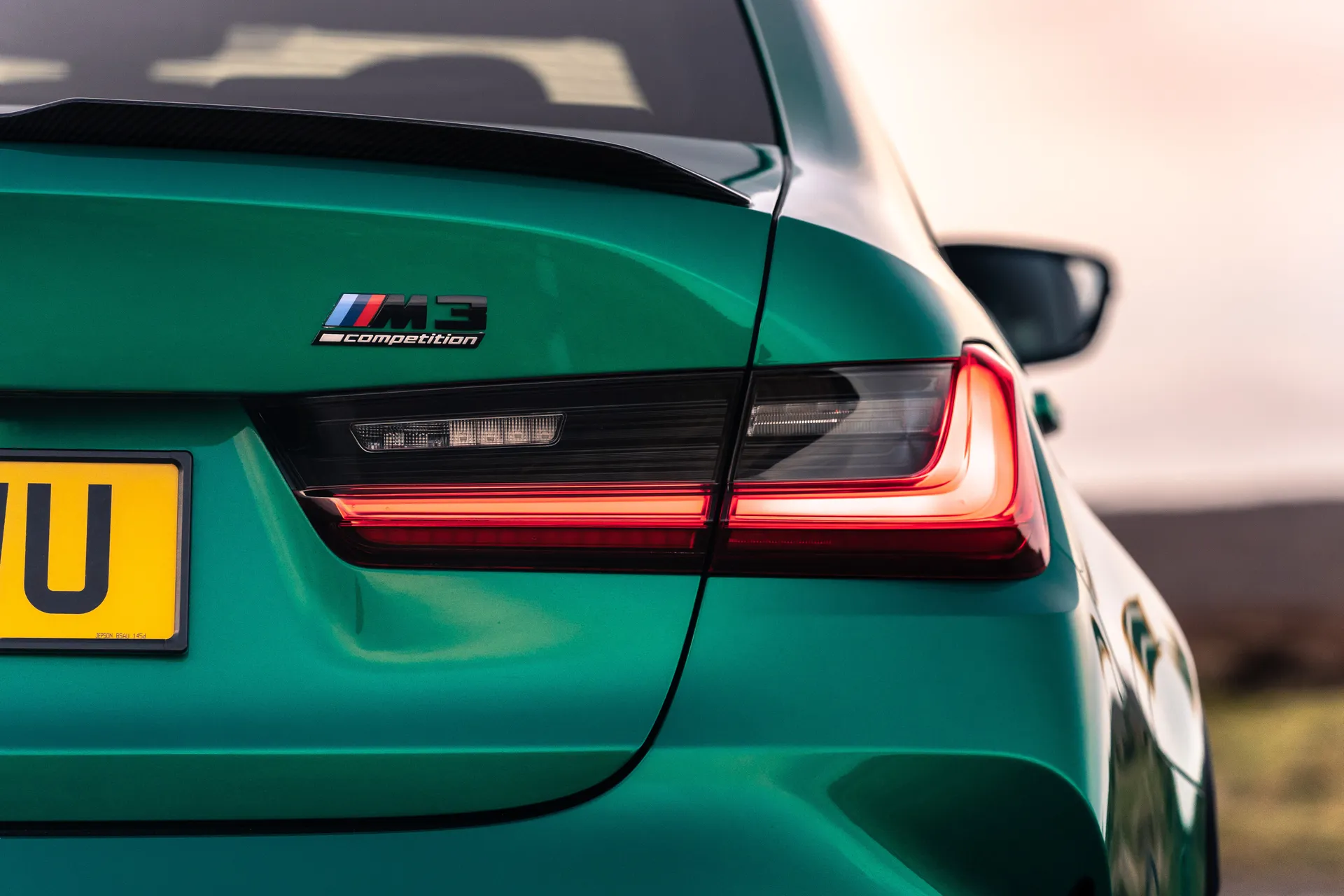
Right now, on-the-road prices for the rear-wheel-drive version of the BMW M3 Competition start at around £81,000 when bought brand new, climbing to £84,000 for the four-wheel-drive version. Go for the CS, meanwhile, and you’ll be paying upwards of £115,000.
There are some big savings to be made on the used car market, though. Browse our listings, and there are several examples of cars that are a couple of years old with fewer than 20,000 miles on the clock (in some cases, a lot fewer) for around the £60,000 mark. Those are savings definitely worth making.
Granted, the Alfa Romeo Giulia Quadrifoglio has been around for a little longer, so older examples of that car can be had for a little less, and still with negligible mileage beneath their wheels. However, a used Alfa Romeo - especially a highly strung one like the Quadrifoglio - is something of a gamble. Used BMW M3 prices look bang-on with those of the Audi RS5 Sportback, meanwhile.
Trim levels and standard equipment
Most of the standard kit you get on the BMW M3 is either the performance-enhancing stuff we’ve already talked about, or the infotainment and safety stuff that we’ve also already mentioned. However, there are a few bits and pieces of luxury kit that are provided besides. Competition versions get alloy wheels (19-inchers at the front and 20s at the rear), heated front seats, M Sport leather seats, three-zone climate control, automatic lights and wipers, LED lighting all round, a head-up display, and cruise control with braking function. As well as all the performance upgrades, the CS gets various additional bits of lightweight CFRP body styling, plus the upgraded M Carbon bucket seats.
Ask the heycar experts: common questions
How much is a BMW M3?
How much horsepower does a BMW M3 have?
How quick is the BMW M3?
Get our latest advice, news and offers
Keep me updated by email with the latest advice, news and offers from heycar.
By submitting you agree to our privacy policy
